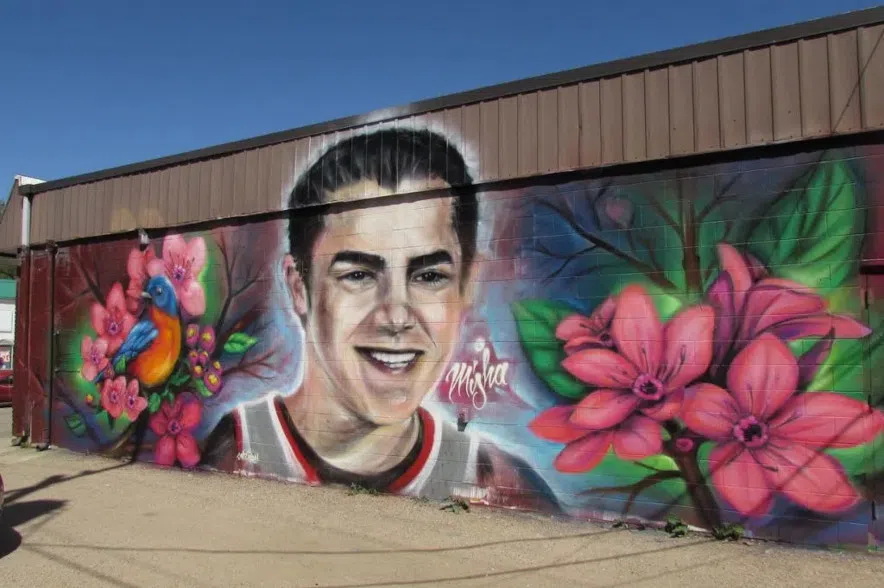Kleenex was passed around and a couple of people had to leave the courtroom on Friday, as the pathologist who did the autopsy on Misha Pavelick in 2006 gave his evidence, complete with photos.
A 36-year-old man is charged with second-degree murder in Misha’s death, but was a youth at the time, so he cannot be publicly named.
Dr. Dino Grammatico told court the injury that caused Misha’s death was a stab wound to the chest that went between two of his ribs and punctured his heart. He said the wound would have bled into Misha’s chest, and he would have died within minutes.
Grammatico said the wound track was about 15 centimetres long. He said it was about two centimetres wide, and there was a blunt side and a pointier side.
In cross-examination by defence lawyer Andrew Hitchcock, Grammatico agreed that the measurement of the depth of the wound track isn’t necessarily very accurate. He said the distance could be changed by movement of the organs from when one is standing and alive to lying down and deceased, or from compression of the chest and soft tissue if a person were stabbed with force.
Misha also had a stab wound on his arm – Grammatico said it was possible it was caused by the same weapon as the stab to the chest, but in response to questions from Hitchcock, he also said it’s possible it wasn’t the same weapon.
Misha had a number of bruises on his torso and face, as well as bruises to his left knuckles. He also had three cuts on the top of his head which Grammatico said were caused by something blunt but couldn’t say whether it would have been a blunt weapon, fists, or feet.
With the aid of a forensics textbook, Hitchcock asked Grammatico about blood on knives. Though Grammatico couldn’t attest to it himself, he agreed the textbook said, in some circumstances, a knife could be plunged into someone, and then, between the tissue contracting and clothing, blood be wiped off the weapon.
Photos also showed Misha’s bloodstained clothes from that night – a pair of blue shorts, a red Jordan basketball jersey, and a black sweater.
DNA evidence
Dr. Melanie Green joined court by video to give evidence about the DNA found in the case. She’s a DNA specialist at the national forensics lab under the RCMP.
Evidence was only presented about one weapon, the folding knife with an eagle on the handle, which court had previously heard was used by Scott Nelson to stab Derek Enns on that same night in 2006.
Green explained there were DNA matches found on the knife for Scott Nelson, Derek Enns and a male who didn’t match any of the known samples on the file. Misha and the accused were known samples.
In his cross-examination, Hitchcock asked Green about an area that had a DNA mixture from at least three people, where Green said it wasn’t suitable for comparison. She agreed with Hitchcock that with these results, Misha could neither be included or excluded as a match.
Misha’s DNA was found on a t-shirt obtained from Andrew Perkins, who had been a part of the fight with Misha that night. DNA from Scott Nelson and the accused were also found on that shirt.
On a t-shirt obtained from Scott Nelson’s house, they also found DNA from Scott Nelson and Misha. Through the trial, Nelson had been identified as either a part of or close to the fights with Misha.
A gas station Band-Aid
There was also a short appearance from another man who was with the group when they went down to Kinookimaw campground. He was a young person at the time, so he cannot be publicly named.
He couldn’t remember too much from that night – unable to say how he got to the campground, how he got back, or any details about what happened at the campground.
When questioning a previous witness, Kayleen Zander, defence lawyer Andrew Hitchcock asked her about surveillance video from a gas station where the group stopped when they got back to Regina.
She identified herself and this witness as the man in the video, and she noted that the man appeared to have blood on his hand. This man was shown the same video by Crown lawyer Adam Breker on Friday, and he also identified himself and Kayleen Zander.
He said he thought the gas station attendant gave him a Band-Aid for the cut on his hand.
The man explained on the stand that he cut on his hand came from him punching a man at Regina Beach, where the group stopped after the campground.
He said it was not the accused that he fought, and that he was not involved in the fighting at Kinookimaw campground.











